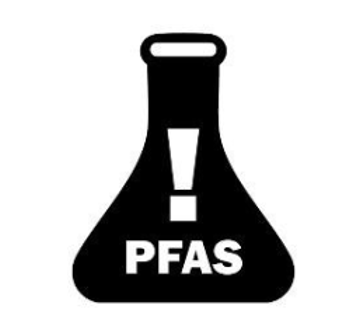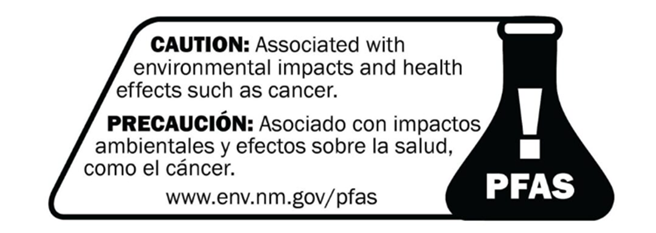Congress advances research on microplastics, Gov. Newsom vetoes California PFAS consumer products bill, New Mexico proposes PFAS labeling requirements, Fifth Circuit extends pause in 1,4-Dioxane suit, and more.
Monthly newsletter Material Concerns: Legal Updates on Substances of Emerging Concern keeps clients informed on the latest legal, regulatory and scientific developments related to substances of emerging concern. Each issue delivers concise, actionable insights to help companies navigate the evolving landscape of environmental law.
New Mexico Proposes PFAS Labeling Requirements
By Associate Kate Klaus
On October 8, 2025, the New Mexico Environment Department (NMED) proposed new regulations to implement the state’s PFAS Protection Act, enacted earlier this year. The proposed rules are now pending review by the state’s Environmental Improvement Board, which will decide whether to adopt them.
If finalized, the rule would impose broad labeling requirements for products containing intentionally added PFAS. Beginning January 1, 2027, manufacturers would be required to label such products to inform consumers of the presence of PFAS. The label must be conspicuous and durable, use words and symbols approved by NMED, and be provided in both English and Spanish. Where product labels are obscured by packaging, the packaging itself must display the required labeling. Additionally, packaging must provide the website for NMED’s PFAS page.
Labeling requirements would differ for “complex durable goods,” defined as goods composed of 100 or more manufactured components, with an intended useful life of five or more years, where the product is typically not consumed, destroyed or discarded after a single use. For these goods, PFAS information would be required in the product’s specification sheet and operation and maintenance manuals. The manual must also identify specific product components containing intentionally added PFAS and their locations within the product.
NMED provided draft labels with its proposed rule, noting that the labels “are not final and may change before finalization of the rules.”

NMED’s draft label for products containing intentionally added PFAS.

NMED’s draft label for consumer packaging of products
containing intentionally added PFAS.
In addition to labeling, the proposed rule sets forth reporting and testing obligations. Beginning January 1, 2027, manufacturers would be required to provide NMED information about the amount and purpose of intentionally added PFAS in their products. This reporting would include the percentage concentration of each PFAS substance present and documentation verifying the analytical method results. If NMED reasonably suspects that a product contains intentionally added PFAS and has not met reporting or labeling requirements, the department would have the authority to require testing or conduct testing itself. Under the proposed rule, violations of PFAS obligations would be subject to civil penalties of up to $15,000 per day.
New Federal Bill Aims to Advance Research on Microplastics and Public Health
By Partner Chris Sorenson
On August 5, 2025, U.S. Rep. Haley Stevens (D-MI) introduced the Plastic Health Research Act (HR 4903), a bill intended to deepen the federal government’s understanding of the health impacts of plastic exposure—particularly microplastics. The bill proposes amending the Public Health Service Act to “expand [and] coordinate programs relating to plastic exposure health research, [and] to authorize grants, contracts, and agreements with respect to such research[.]”
If enacted, the bill would allocate $10 million annually from fiscal years 2026 through 2030 to support grants, contracts and cooperative agreements for research into microplastics exposure. A key component of the bill is the establishment of dedicated research centers to serve as hubs for scientific inquiry into how microplastics affect human health. The initiative has garnered support from the American Chemistry Council (ACC), which has emphasized the importance of filling current knowledge gaps. According to the ACC, a more robust scientific foundation will enable lawmakers and policy experts to make informed, evidence-based decisions regarding plastics and public health.
As public concern over microplastics continues to grow, HR 4903 represents a significant step toward a coordinated national effort to understand and mitigate potential health risks associated with plastic exposure. Microplastics have been detected in diverse environments—air, water, food and even human tissues—yet research lacks standardized testing methodologies, potentially leading to inconsistent results. The act seeks to remedy fragmented study approaches by promoting standardized definitions, validated reference materials, and improved comparability across independent studies.
HR 4903 has been referred to the House Committee on Energy and Commerce but currently remains in the introductory stage of the legislative process. The bill is co-sponsored by Republicans including Frank D. Lucas (R-OK)—pointing to early bipartisan alignment on microplastic health research.
California Governor Vetoes PFAS in Products Bill, Citing Concerns with Availability of Affordable Household Products
By Associate Abby Fears
California Gov. Gavin Newsom vetoed SB 682, a bill that sought to prohibit the sale and distribution of cookware manufactured with intentionally added PFAS. The bill proposed phasing out PFAS in cookware by 2030, and in other products, including products for infants and children, food packaging, dental floss, and cleaning products, by 2028. Environmental and health organizations such as the Natural Resources Defense Council supported the bill, while opponents included celebrity chefs and the Cookware Sustainability Alliance.
In his October 13, 2025, veto, Newsom expressed his concern about the bill’s impact on the affordability of cookware products, saying “the broad range of products that would be impacted by this bill would result in a sizable and rapid shift in cooking products available to Californians.” While acknowledging the bill’s intent to protect the health and safety of consumers, Newsom expressed deep concern “about the impact this bill would have on the availability of affordable options in cooking products.” He encouraged continued dialogue to address the prevalence of PFAS.
Other states, including Illinois, Colorado, Vermont and Connecticut, have passed laws similar to California’s failed SB 682, banning PFAS in different products, such as cookware. However, California’s PFAS bill was regarded to be one of the strictest in the country. The California senator who introduced the bill said he would continue to work on the issue in the future.
WWII-Era Manufacturers Eye Federal Reimbursement for Environmental Cleanup Costs
By Partner Dalton Mott
Manufacturers grappling with the environmental consequences of World War II-era production may find their government supply contracts provide a legal basis for seeking costs recovery from the federal government. During World War II, the United States urgently demanded vast quantities of supplies and material to support the war effort. The response by American industry was overwhelming. Companies across nearly every sector of industry entered into contracts with the government to meet the industrial wartime demands at an unprecedented scale. Today, industry burdened by the modern environmental consequences of its war-time response need not shoulder the costs of environmental cleanup alone. Instead, manufacturers are dusting off their decades-old supply contracts to unlock remedies potentially available to them to ensure the United States pays its fair share for such costs.
Companies seeking to hold the United States accountable for environmental contamination arising from World War II-era industrial activities may find a viable avenue under the Tucker Act, 28 U.S.C. § 1491. The Tucker Act grants the U.S. Court of Federal Claims jurisdiction over monetary claims against the federal government, including those based on contractual obligations. Recent decisions have affirmed that costs associated with wartime production may be reimbursable under World War II-era contracts. For example, in Shell Oil Co. v. United States, 751 F.3d 1282 (Fed. Cir. 2014), the Federal Circuit held that certain environmental cleanup costs could be “charged” back to the government pursuant to its contractual commitments.
An essential first step in evaluating the viability of a Tucker Act claim is a close analysis of a company’s World War II-era government contracts. These contracts varied significantly in form and substance. Some included express indemnity provisions, which may directly support a claim for reimbursement. However, relief may still be available even in the absence of an indemnity clause. Courts have recognized that contractual language shifting responsibility to the United States for additional taxes, fees or charges incurred by the contractor as a result of wartime activities may suffice. In Shell Oil, the Federal Circuit found that the government was contractually obligated to reimburse Shell for environmental cleanup costs, based on provisions requiring the government to cover certain expenses arising from wartime production.
Alternatively, the Comprehensive Environmental Response, Compensation, and Liability Act (CERCLA), commonly known as Superfund, provides a statutory framework for the cleanup of hazardous waste sites and imposes liability on parties responsible for contamination. CERCLA renders federal agencies subject to the same liability standards as private entities, including cleanup obligations at federally owned or operated facilities. Courts have applied this provision to World War II-era sites where the federal government exercised substantial control over industrial operations. In Exxon Mobil Corp. v. United States, 108 F. Supp. 3d 486 (S.D. Tex. 2015), the court found the government liable under CERCLA due to its operational involvement in wartime production facilities. Similarly, in FMC Corp. v. United States, the Third Circuit held the government jointly and severally liable under CERCLA as an “operator” and “arranger” of hazardous waste disposal at a rayon manufacturing facility, based on its pervasive control over production processes during the war.
The next step in pursuing recovery is determining whether the Tucker Act or CERCLA provides the appropriate legal avenue for your claims. Each path presents distinct procedural and strategic considerations. Because Tucker Act claims are grounded in contract law, they may be subject to different accrual and tolling rules than those governing CERCLA actions. Some parties have opted to pursue both avenues simultaneously, filing parallel proceedings in separate courts to preserve their rights under both statutory and contractual frameworks.
To date, most litigation involving World War II-era government contracts has centered on the recovery of environmental remediation costs. However, it is possible that other categories of costs may also be recoverable, including those related to government-imposed penalties, nuisance claims or even personal injury. While these theories of recovery are less established and have not been widely tested in court, they may present new opportunities for companies seeking to shift liability to the federal government. Success under these alternative theories would likely depend on the specific language of the wartime contracts and the extent of the government’s involvement in the underlying conduct.
California Deadline for Climate Related Financial Risk Disclosures Approaches—The Most Expansive Corporate Climate Reporting Framework in The United States
By Partner Jad Davis
The first deadline under California’s Climate Related Financial Risk Disclosure Program—California SB 261 (codified as California Health & Safety Code section 38533)—is quickly approaching. By January 1, 2026, companies, doing business in California with annual revenue exceeding $500 million must submit their initial biennial public report to the California Air Resources Board (CARB) on their climate-related financial risk and the measures adopted to reduce those risks.
CARB estimates that approximately 4,160 companies are required to meet these reporting requirements. On December 1, 2025, CARB will make available a public docket for companies to post links to their climate-related financial risk reports. CARB will keep the docket open till July 1, 2026.
So, what must companies report under Section 38533?
CARB’s September 2, 2025, Climate Related Financial Risk Disclosures: Draft Checklist provides guidance on minimum reporting expectations consistent with the four “pillars” found in the Task Force on Climate-related Financial Disclosures (TCFD):
- Governance: a description of governance structures for identifying, assessing and managing climate-related financial risks and opportunities;
- Strategy: a description of actual and potential impacts of climate-related risks and opportunities on the company’s operations, strategy and financial planning (where material), taking into consideration the future impacts of climate change under various climate scenarios;
- Risk Management: a description of how climate-related risks are identified, assessed and managed; and
- Metrics and Targets: description of the metrics and targets used to assess and manage relevant climate-related risks and opportunities.
The CARB guidance also clarifies that a subsidiary do not need to submit a climate-related financial risk report if its parent reports on its behalf.
On September 25, 2025, CARB sent an email with CARB’s Preliminary List of Reporting/Covered Entities and Stakeholder Survey of reporting/covered entities under Section 38533. Companies should check to see if they are on the list. It is noteworthy that CARB does not represent this as a comprehensive list and companies should determine if they are a reporting entity under Section 38533, even if they are not on this list.
D.C. District Court Dismisses Lawsuit Regarding PFAS in Biosolids
By Associate Caitlin Robb
A federal district court has dismissed a lawsuit brought by farmers, environmental groups and local governments accusing the U.S. Environmental Protection Agency (EPA) of failing to meet its statutory duty under the Clean Water Act (CWA) and Administrative Procedure Act (APA) to identify and regulate PFAS in agricultural biosolids. Farmer v. EPA, No. 24-1654 (D.D.C., filed September 29, 2025).
Specifically, the plaintiffs alleged that EPA failed to identify 18 PFAS chemicals present in biosolids and failed to regulate 11 PFAS chemicals previously listed in EPA’s biennial reports. They claimed these omissions posed risks to public health and the environment, and asked the court to order EPA to take regulatory action within specific deadlines.
The court dismissed the CWA claims because “[e]ven assuming that Section 402(d)(2)(C) requires EPA to identify and to regulate additional sewage-sludge pollutants at some point, it does not specify a ‘date-certain deadline’ by which the agency must do so.” The court found that the CWA only requires EPA to “review” its regulations every two years; it does not require the agency to take further regulatory action within a specific timeframe. Without a clear, non-discretionary duty tied to a deadline, the court lacked subject-matter jurisdiction over the plaintiffs’ CWA claims.
The court also dismissed the APA claims because EPA’s biennial report is “informational in nature” and “is not a final agency action” because “it does not tell regulated parties what they must do or may not do in order to avoid liability.” Therefore, without a final action subject to judicial review, the plaintiffs failed to state a claim under the APA for which relief could be granted.
While the court made clear that biennial reviews alone cannot be used to force regulatory action, it noted that interested parties, including the plaintiffs, may still petition EPA to initiate rulemaking, and a denial of such a petition could be subject to judicial review. This decision may prompt further alternative administrative or legal actions from industry groups seeking to address the regulation of PFAS and biosolids, and also outlines the procedural hurdles for those seeking to compel EPA action.
Fifth Circuit Extends Pause In 1,4-Dioxane Suit Amid Government Shutdown
By Associate Jacob Taylor
The U.S. Court of Appeals for the Fifth Circuit has granted the U.S. Environmental Protection Agency (EPA) another 90-day extension in its litigation over the Biden administration’s revised evaluation of 1,4-dioxane (1,4-DX) under the Toxic Substances Control Act (TSCA). This pause, requested by EPA, is intended to allow continued review of the chemical’s cancer risk assessment. Union Carbide Corp. v. EPA, No. 24-60615 (5th Cir., filed September 30, 2025).
In 2020, during the final days of the first Trump administration, EPA concluded that 1,4-DX poses unreasonable risk to workers in 13 of 24 evaluated conditions of use. But the 2020 evaluation also concluded that the chemical poses no unreasonable risk as a byproduct in consumer products. In a 2024 evaluation, the Biden EPA reversed course, concluding that 1,4-DX poses unreasonable risk across its uses, including byproduct exposures previously deemed safe. Industry groups challenged the revised assessment, arguing that EPA’s use of a linear model to evaluate cancer risk deviates from scientific consensus and leads to overly stringent regulations.
EPA’s current review centers on this cancer risk methodology. In May 2025, Nancy Beck, EPA’s Principal Deputy Assistant Administrator for Chemical Safety, estimated the review would take 12 to 24 months. By June, she truncated that estimate to 12 months while noting that it was EPA’s goal to complete the review within six months. Beck now reports progress toward that goal, including hiring a contractor to review relevant studies and reports.
But the government shutdown that began on October 1, 2025, will likely delay progress—potentially significantly. According to EPA’s contingency plan, TSCA programs are not included in the list of significant agency activities that will continue during the funding lapse. The contractor EPA engaged may also be limited in its capacity to work during the shutdown per the terms of its agreement with EPA. Historical precedent—namely the 34-day shutdown during President Donald Trump’s first term—suggests even short shutdowns can significantly disrupt EPA operations by compounding existing backlogs in chemical evaluations and regulatory timelines. Thus, even if the government is funded in the near term, a ripple effect caused by halted agency projects could reverberate through EPA after the shutdown ends.
Manufacturers and users of 1,4-DX should therefore anticipate potential regulatory tightening and prepare for extended uncertainty in TSCA implementation timelines. Strategic engagement with EPA and legal counsel is advised to navigate evolving compliance obligations and risk assessments.











